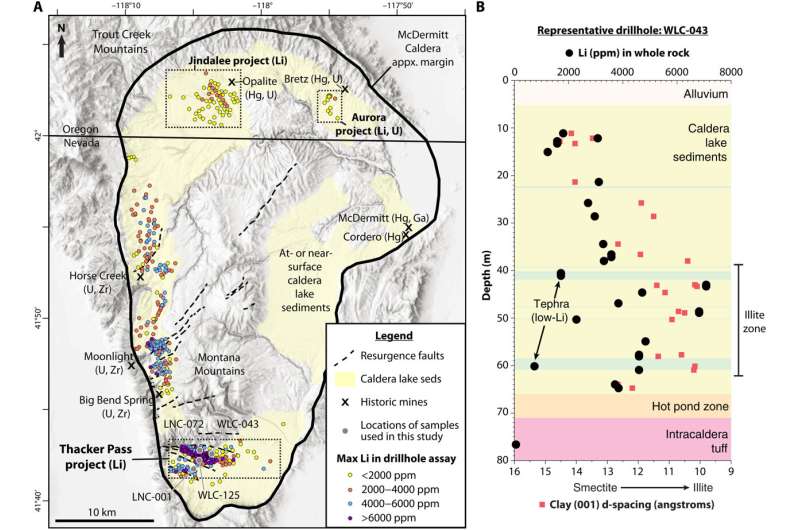August 31, 2023 report
This article has been reviewed according to Science X's editorial process and policies. Editors have highlighted the following attributes while ensuring the content's credibility:
fact-checked
peer-reviewed publication
trusted source
proofread
New evidence suggests McDermitt Caldera may be among the largest known lithium reserves in the world

A trio of volcanologists and geologists from Lithium Americas Corporation, GNS Science, and Oregon State University reports evidence that the McDermitt Caldera, on the Nevada/Oregon, border, may host some of the largest known deposits of lithium on Earth. In their project, reported in the journal Science Advances, Thomas Benson, Matthew Coble and John Dilles studied parts of the caldera and developed a theory to explain how so many lithium deposits were formed in the area.
Over the past few decades, lithium has become a highly valued soft metal, due primarily to its use in a wide variety of battery types. Because its value has continued to increase, scientists working for mining companies such as Lithium Americas Corporation have been looking for sources.
The McDermitt Caldera is approximately 45 kilometers long and 35 kilometers wide. Prior research has suggested it formed as part of the Yellowstone hotspot, which led to the formation of a sequence of calderas. Its origin dates to approximately 19 million years ago.
In 2017, another team of researchers found evidence that one part of the caldera called Thacker Pass could be among the largest sources of lithium ever found. Lithium Americas obtained a stake at the site and began testing mining operations. Soon thereafter, they ran into opposition from locals and Native American groups, but eventually won the right to mine at the site.
Since that time, the research team has been collecting and analyzing samples, looking for the best place to begin major mining operations. But to find it, they and many other experts in the field believe they must find an explanation for how the lithium got there in the first place. In their paper, the researchers suggest a theory—one Lithium Americas plans to use to begin its mining operations.
Their theory posits that after a volcano erupted, a hydrothermal enrichment occurred—magma deep unground pushed its way to the center of what is now the caldera, leading to the formation of the Montana Mountains. As that happened, faults, fissures and fractures were created, allowing lithium to seep up toward the surface. This process also transformed much of the smectite into illite (different forms of clay minerals), which wound up along the southern rim of the basin. That, they conclude, explains why lithium is so abundant there.
More information: Thomas R. Benson et al, Hydrothermal enrichment of lithium in intracaldera illite-bearing claystones, Science Advances (2023). DOI: 10.1126/sciadv.adh8183
Journal information: Science Advances
© 2023 Science X Network


















